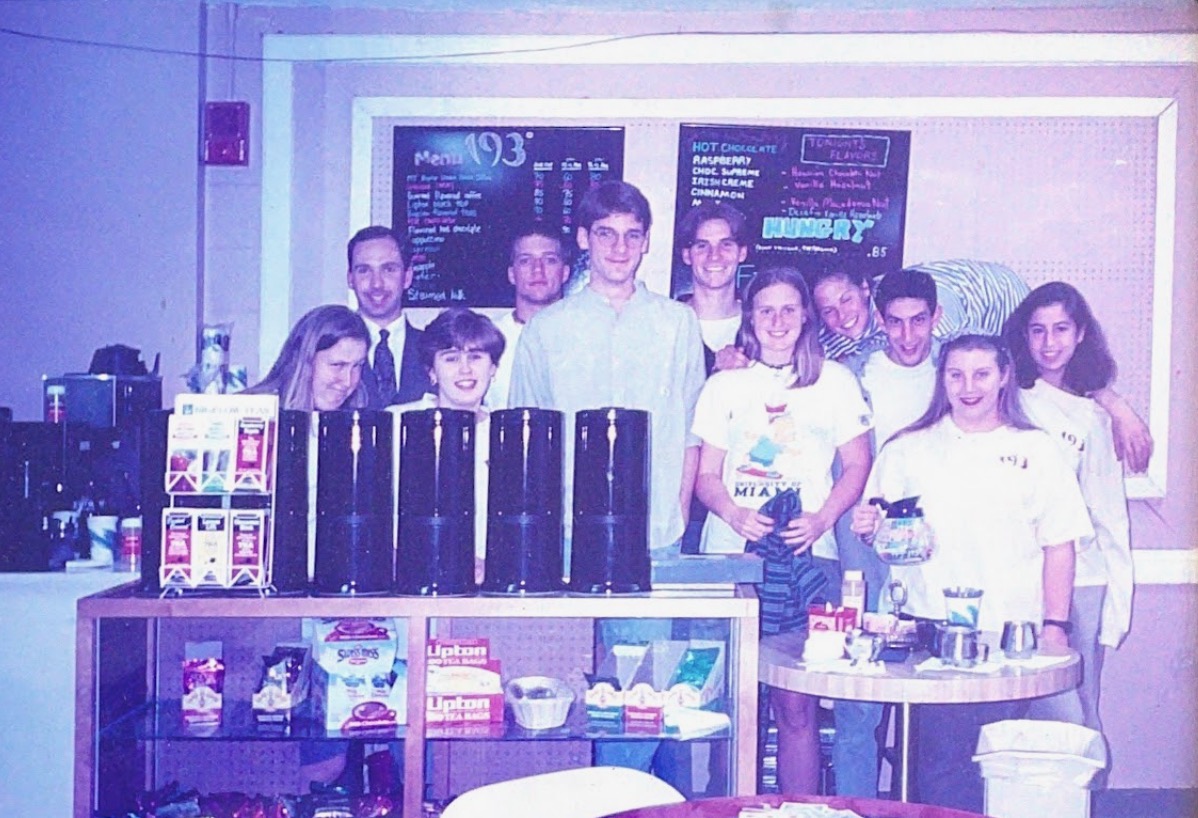The original staff of 193 Degrees Coffeehouse from its opening in 1994. Photo Courtesy of Adam Naftalin-Kelman.
The original idea for 193 Degrees Coffeehouse was brewed up on a Sunday morning in Butterfield Dining Hall during the fall of 1994.
The Coffeehouse was founded by Adam Naftalin-Kelman in 1994, alongside a group of students at the University of Rhode Island who were looking for a place to hang out on campus after hours.
Naftalin-Kelman and a few of his fellow RA’s came together to advocate for a welcoming space for students to hang out at night. He described his group as “a collective of eclectic kids” who were bored looking for something to do.
With the concept envisioned, the group started the search for a space to make that come to fruition.
Quickly though, they learned they would have to roll with the punches. The students needed to fill in a lot of gaps.
“We didn’t even drink coffee,” said Naftalin-Kelman. “No one had a clue what they were doing.”
According to him, all they knew was that they wanted to create an environment similar to Central Perk from the TV show “Friends.”
First, according to Naftalin-Kelman, the students needed to be approved to access and use the Memorial Union at night, but their vision hinged on creating a spot for students to hang out at night. This vision received a lot of pushback because the Memorial Union closed at 8 p.m. every night.
With some work, the late-night hours they wanted were approved due to students working in the Memorial Union who volunteered to stay late and lock up after the Coffeehouse closed.
Next, the students creating the Coffeehouse actually needed to learn how to make a cup of coffee. They reached out to a coffee roasting company called “East Coast Roasters,” who agreed to help the students learn about coffee.
A representative from the company came to explain to Naftalin-Kelman and his friends what kind of coffee they needed and explained the best temperature for the coffee to be brewed at was 193 degrees Fahrenheit.
This is how the name of the 193 Coffeehouse was created. As one of their artistic friends doodled that number on their notes during the meeting, they knew it would be the logo for their project, Naftalin-Kelman said.
All they needed after that was a space to work. However, it was not in the same location as it is today; it all started in a small room on the bottom floor of the Memorial Union, according to Naftalin-Kelman.
With the couch from “Friends” in mind to use in their lounge, the group thrifted an orange couch as the first piece of furniture in their space.
In November 1994, 193 Coffeehouse opened for the first time. In the beginning, they were only open on Thursday-Sunday from 8 p.m to 10 p.m. Soon enough, they were granted approval to stay open until midnight on Fridays.
On the nights they were open, Naftalin-Kelman said they would pull out their furniture and create their lounge next to their small room.
It wasn’t until later that school year that 193 was able to obtain that space they’re in now. Ann Morrisey, the coordinator of student affairs, recalled the meeting “where the students were asking for a bigger space, it still gives [her] chills to this day.”
The students wanted to convert a study room that was barely used to the new space for the Coffeehouse. Their strategy to get the room, according to Naftalin-Kelman, was to propose using the atrium, but then say they would be able to use the study room.
This tactic worked, but not without the help of then-President Robert Carothers, who “really believed” in 193, according to Morrisey and Naftalin-Kelman.
“President Carothers was a huge advocate for us because he loved to see that kind of leadership,” Naftalin-Kelman said.
In the meeting, there was a moment where President Carothers walked in, sat down and told the administrator to “give the students what they need” and then walked out, Morrisey recalled.
They were then able to move upstairs into their current space and provide a permanent space for people to come and be themselves.
“193 taught me more than any of my classes did,” Naftalin-Kelman said. “As an accounting major, I was following in my family business.”
However, he was able to use the Coffeehouse for independent study, which helped him change career paths.
Although the Coffeehouse has changed over the years, Naftalin-Kelman said he is glad to hear that it has changed, since, as he said, things are not meant to stay the same.





